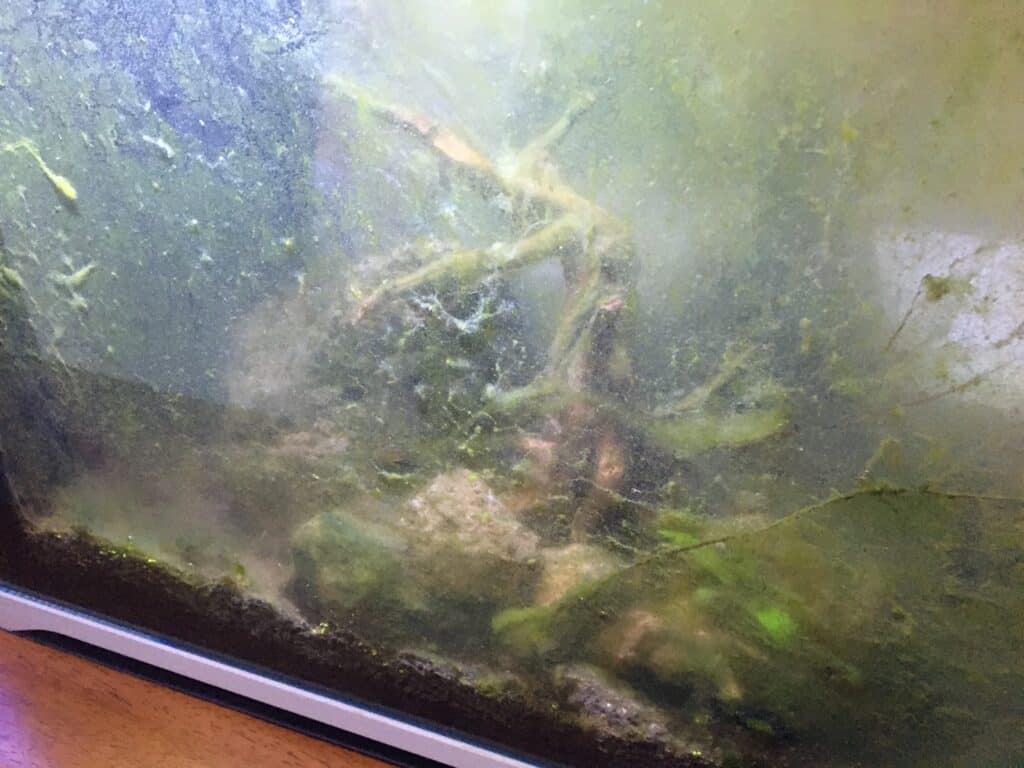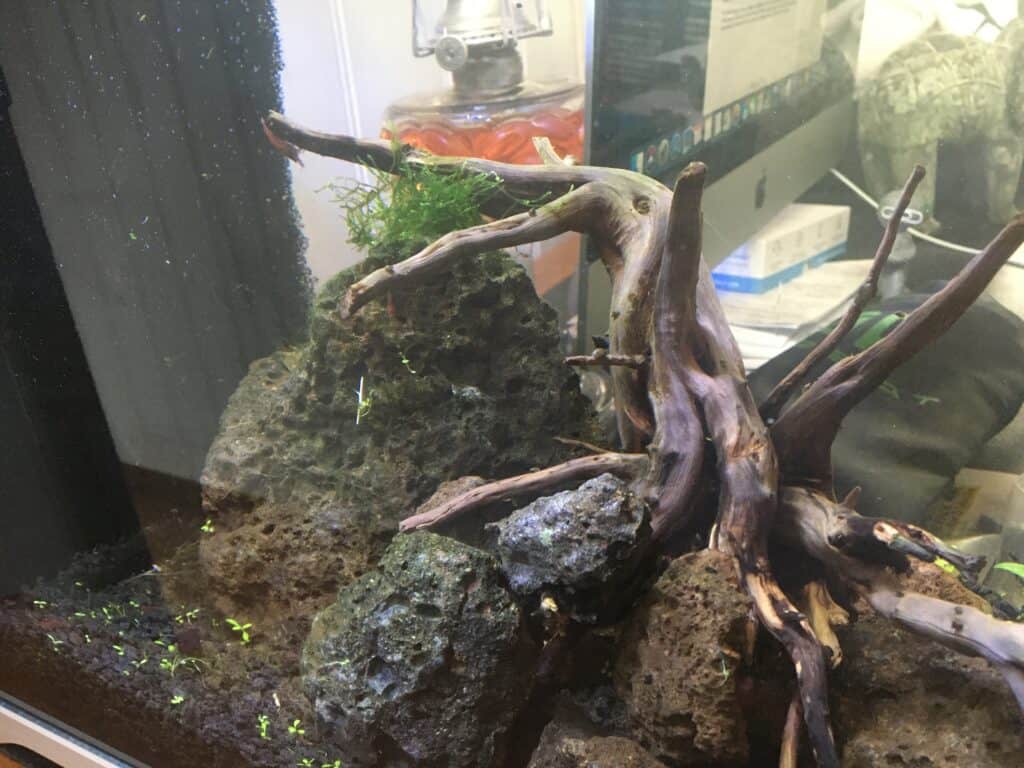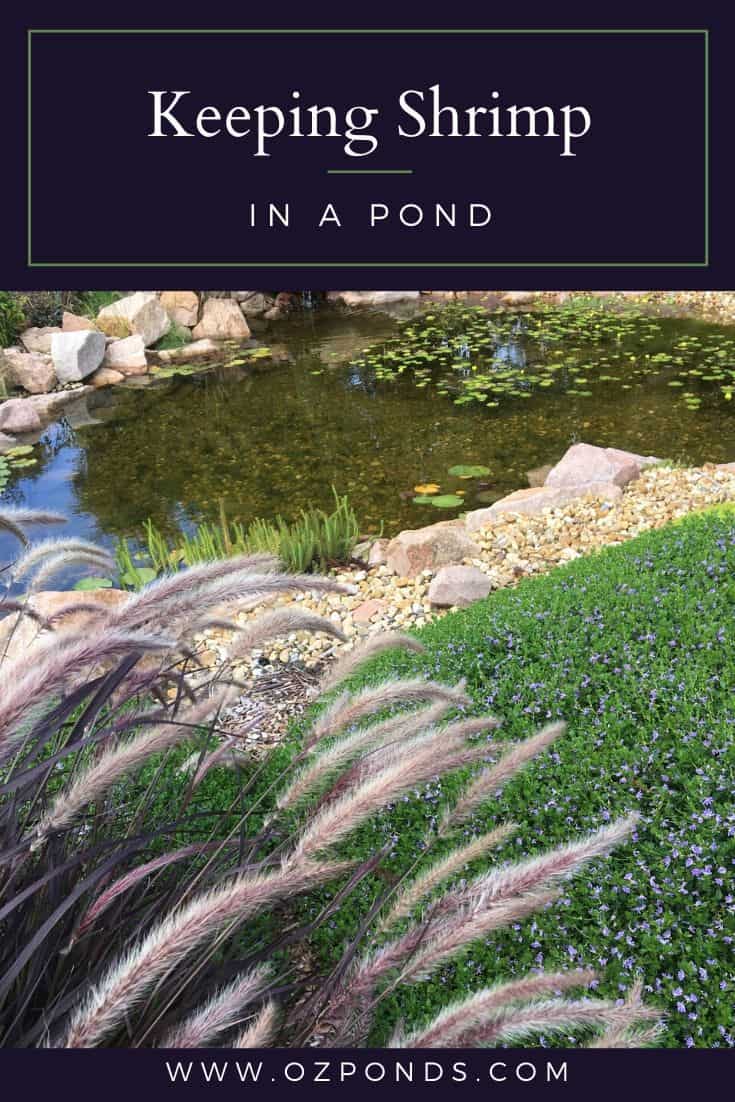I decided to add shrimp to my ponds for a couple of reasons. Number one they will feed on the algae and bio film in the pond. Number two they will provide live food for the fish. Basically adding shrimp to my ponds i feel will improve the entire pond ecosystem.
If i add shrimp will they eat algae?
Anyone who’s ever kept shrimp in their aquariums already knows the answer to this question- Absolutely!
Freshwater shrimp are natures ultimate garbage crew. The moment you introduce them to a pond or aquarium they get straight to work. Below are some pictures of an aquarium before shrimp and after shrimp. See if you can notice a difference 😉

Before shrimp 
After shrimp
But not only will shrimp consume algae… they will also consume leaf litter, uneaten fish food and biofilm. By eating these organic material they also prevent algae.
I find in my ponds after a few years the bio film and algae builds up quite a lot, on the rocks and pebbles within the pond. Normally most people will bite the bullet and do a full scale pond clean out. If you add shrimp they will clean all this for you!
Will shrimp even survive in a garden pond?
Well that depends firstly on the type of shrimp. Those of you lucky enough to live in tropical locations can choose from a huge range of shrimp, basically anything available through the aquarium trade is available to you.
Those of us who live in colder areas need to be more careful on the types of shrimp we can keep outdoors in our ponds. I live one hour east of Melbourne, Australia. For me there was only really one choice available through the local aquarium trade- Australian glass shrimp (paratya australiensis).
You could also always collect some from local waterways, that way you’re guaranteed they are adapted to your temperatures. Just make sure it’s legal to do so.
The other thing you’ll need is plenty of vegetation, rocks or other nooks and crannies. Shrimp are at the bottom of the food chain and have no defence except being small and able to hide. Without somewhere to hide they won’t reproduce and pretty quickly you’ll have no more shrimp.
How do i stop fish from eating the shrimp?
Simple answer you can’t!
Sorry folks but it’s the circle of life. They best thing you can do is provide plenty of shelter with many plants. Remember out in the wild, fish and shrimp coexist.
You just need to try and replicate nature as best as possible. Your pond will need areas with really thick vegetation. Places that fish cannot get into.
Another thing is if you have larger fish like koi and gold fish keeping an active shrimp colony within the pond is going to be near impossible. What i have done is set up a small tub with plants, rocks and gravel. This tub has no fish in it. Here the shrimp can breed without predators.
As the colony grows i add shrimp into my other ponds this way i always have an active colony, so if the fish eat all the shrimp in a particular pond i can replace them without needing to buy new ones.
I have a sponge filter and a couple of air stones providing filtration and water agitation. There were a few mozzie larvae in the tub when i added the shrimp but not anymore. I don’t think the shrimp are eating them but I’m not sure. I think it’s more the water agitation that is keeping them away.
Perfect pond ecosystem
- For me a perfect pond ecosystem requires practically zero human intervention. Shrimp have quickly become a valuable addition to my pond ecosystem. To create a perfect ecosystem I use 5 steps. Provide plenty of biological filtration. Everyone with a pond or keeping fish must understand the nitrogen cycle (click to learn more). This keeps the water safe for fish. The best biological filtration you could possibly add is a wetland or bog filter (click to learn more). I also add rocks and gravel inside the pond. This adds even more surface area for good bacteria’s to live on.
- Adding lots of plants. Aquatic plants are able to remove nutrients directly from the water. This allows them to outcompete algae. It also completes the nitrogen cycle perfectly by removing the build up of nitrate. Without plants water changes would be necessary to maintain optimal water conditions. Lastly plants will provide shade. Shade reduces the water temperature and blocks the sun, very valuable at keeping algae at bay.
- Circulation and oxygen. While it is possible to create a thriving pond ecosystem without the use of circulation and oxygen it is much harder (click here for more info). Circulating the pond allows more water to come into contact with those essential good bacteria’s. Oxygen allows those bacteria’s to purify water much faster.
- Utilise a pond skimmer, collection point or overflow (click to read more). In nature all healthy ponds will overflow allowing some of the build up of organic material (leaves, fish poo etc) to leave the pond. We can replicate this by providing an area where this debris will be collected. We can then easily remove it without much effort.
- Encourage or add wildlife. If you build it they will come. In my yard I have 2 largish ecosystem/ wildlife ponds. On both occasions within days of building there were frogs, water boatmen and other strange and wonderful water creatures. Water is essential to life and life is drawn to water. Adding fish, shrimp, snails and fresh water mussels all build on and enhance the complete ecosystem.
I do hope you found this and the other articles linked helpful. If so subscribe to my mailing list for helpful pond tips. I am obsessed with ponds and am always adding more or tinkering with the ones I have. Thanks for reading 🙂

